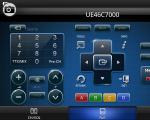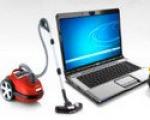Installing a Windows 10 printer
Installing a printer in the Windows 10 operating system is usually a simple process that will take no more than 10 minutes of your time. After installation, you can immediately start printing your documents without any problems.
The most common way to connect the printer to a PC is a USB cable, also connect peripheral device possible by Wi-Fi networks, If technical capabilities allow this. Below we will look at both options in detail.
The process of adding a printer to the system can be divided into several steps:
Step 1. Connect the printer to your computer using a USB cable and turn it on.

Step 2. Open Settings from the Start menu.

Step 3. Left-click on the icon labeled “Devices”.

Step 4. On the “Printer” tab, click on the “Add a printer or scanner” button.

Step 5. If your printer is detected, click on it and follow the on-screen instructions to complete the installation. If you do not see the printer in the list, click on the “Find Printer” link - follow all the instructions in the “Troubleshooting” window that opens.

In addition, you can install drivers manually by first downloading them from the manufacturer’s official website.
Adding a wireless printer
Algorithm Wi-Fi installations printer depends on the specific brand and model of the device. However, most modern printers automatically detect your home network and automate the installation process. Let's look at a scenario where this doesn't happen:

Note! In some cases, you may need to temporarily connect the printer to your computer via USB to install the device software. If there is a problem, first make sure that the printer is relatively close to the PC and not too far from the router(s). Some printers have a built-in Ethernet connector, through which it can be connected directly to the router - the settings are controlled through the Internet browser interface.
Adding a shared printer
Home function Windows network"HomeGroup" allows you to use the same printer from several computers and exchange files between them within one local network. Below we will show you how to create a shared group and connect a printer to it.
Setting up a home group
Skip this step if your home network already configured. In case you are not sure, follow steps 1 and 2 to find out the current network status.

Connecting the Printer to a HomeGroup

Installing a printer on the Windows 10 operating system is not a difficult task. Follow the instructions and you will definitely succeed!
Video - How to install a printer on Windows 10
Microsoft has tried to simplify the process of adding a printer to Windows 10. Now that the process is automated, connecting should not be a problem. Most printing devices are connected to your PC via a USB port and often work as soon as you plug them in (and many work over wireless network!). Your new printing device may also come with a driver disc.
For the user, the connection should be quick. The optimized process mainly depends on automatic detection and identification. When everything works correctly, installation will only take a minute or two.
Here's how to add a printer
Sign in to your computer under Windows control With account administrator. Connect your printing device to your PC. Click the Start button on your desktop. From the Start menu, select Settings. In the Settings window, open Devices. Once the Devices window opens, make sure the Printers and Scanners category is selected.
In the right pane, click Add a Printer or Scanner.
Wait while the operating system searches for a connected printing device. When Windows finds it, you can click its name and follow the on-screen instructions to complete the installation process.
If the operating system cannot detect the connected printing device, click "The printer you want is not listed." In the Find a printer with other settings window, click the Add a local or network printer with manual settings button using the manual settings switch.

Note: If you are an advanced user, you can also select a different option from the Use drop-down list existing port».
In the Driver Installation window, from the displayed list of manufacturers on the left side, click to select the one to which the connected printer belongs. On the right side, select the specific model of the printing device connected to the PC.

Note. At this point, you can also click the "Have Disk" button and find the required driver. Click Next to proceed to the next step.
In the "Enter a name" field, enter information name for the printer and click Next. In the Sharing window, make sure that general access so that other network users can find and use it. If you don't want to share your printing device with network users, you can select the appropriate option. In the Share Name field, enter a short name.
Note. The name you enter here will be displayed to remote users when they search for this printer on the network.
If you wish, you can fill out the "Location and Comment" fields. Click Next to continue.
On the last page of the wizard, click the "Print Test Page" button to check that the connection is correct and functioning correctly. Click "Finish" to complete the process.
Most Windows users, after update operating system Before Windows 10, there is a problem detecting a printer or MFP connected to the PC. The computer simply doesn't see it. Let's solve this problem.
First, just in case, we need to check the serviceability USB port(suddenly you accidentally pulled the cord and it malfunctioned). You also need to check whether the wire is plugged into the device, since it may be disconnected from the PC.
You should also inspect the printer itself: is it turned on, does it have ink, etc. If any of these happen, fix the problem and check the device's connection to the computer again.
If everything is in order, then let’s move on to troubleshooting the operating room itself Windows systems 10.
Check for problems.
First, you can use the built-in program to diagnose problems. It is installed automatically along with the installation of Windows 10.
To enter the troubleshooting module you need to do the following:
- Go to the Start menu;
- Click on “Control Panel”;
- In the category, select large icons;
- Click on the “Troubleshooting” item;
- Then select “Hardware and Sound”;
- Select “Use the printer”;
After clicking on the last item, the troubleshooting program will launch. It will check the printer connections, required services and drivers.
Connecting the printer to a PC.
The troubleshooter may not be able to resolve the issue and may not be able to see the print device. Therefore, you should try to install it yourself. There are a couple of ways to do this:
- You need to go to the settings item through the control panel or simply press the “Win + I” keys. Then go to “Devices” and select “Printers and Scanners”. Click the "Add a printer or scanner" button and wait a moment. In some cases, Windows 10 does not see the printer, but there are times when the system successfully connects and installs it. In this case, the Internet must be connected to the PC.
- The printer you need may not appear in the search results. Then click on the “The printer you need is not listed” button under the green search bar. This way, you can install the device using filters and specify the path to the drivers on the site. The program itself will download them and install them.
How to install drivers manually.
If after Windows installations 10 the printer does not work and the above options to solve this problem did not help, then you should do everything manually. You need to download and install printer drivers yourself. To do this, you need to go to the device manufacturer’s website and select a driver for your model. It must be downloaded for Windows 10.
After identifying problems with Windows 10, users have already posted printer drivers from many manufacturers, and therefore finding them on the Internet is not difficult.
If you could not find a suitable driver for Windows 10, then download it for Windows 7 or 8.
Before installing a new driver, it is better to remove the old one, otherwise some errors may occur. To do this, go to “Settings”, then “Devices”. Remove the printer by right-clicking and selecting “Remove device”.
Developer recommendations for Windows 10 support.
For example, HP claims that there should be no problems with most of their devices. For devices that worked properly before Windows updates 10 drivers do not need to be updated. In it you can also find information on how to troubleshoot problems when the computer does not find the printer.
Printing device manufacturer Epson also supports users. All are located on the company's website necessary drivers and you can download them at any time.
Canon printer developers, like HP, say that most printers will work on the new operating system without problems. Drivers can also be downloaded from their official resource.
After installing the drivers, there should be no problems. But if none of the above helped you, you can look for a solution to the problem for specific model devices. Maybe someone had similar problems and shared their solution on the forums. There are also English-language sites, but this requires knowledge of English.
What to do when none of the proposed options worked?
There are also cases when the printer does not print after all the manipulations performed. Why doesn't it work?
If you are reading this, then most likely the Windows 10 operating system will not be able to accept your printer. If you have any doubts, contact experienced professionals for advice.
You may not be able to find suitable drivers for your device. And if you don’t want to buy a new printer, then all you have to do is return the previous operating system. Search the Internet for information on how to do this.
Printer manufacturers cannot develop a uniform procedure for installing printing devices in a computer. That is why installing a printer in Windows 10 can be done in one of the following ways.
In some cases, you will only need to connect the printer to the appropriate computer port (usually USB) and wait a little. Windows 10 will automatically find and recognize your new device, then connect it and prepare it for use. All you have to do is refill the printer with paper, ink or toner.
Many manufacturers, striving to remain as independent as possible from software developers, require the installation of special proprietary software to successfully connect printers to a computer. If, before connecting the printer using a cable, software If you do not install it on your computer, the printing device will not work. Printer troubleshooting guide: Troubleshooting Windows 10
Fortunately, you can determine how to install your printer on your computer by reading the documentation that came with it. (Most often, printer installation instructions appear on a separate sheet of paper labeled Quick installation.) If your printer did not come with instructions for connecting to your computer, insert the print cartridge(s), load paper, and then follow these steps:
After booting your Windows 10 computer, connect the printer to it using a separate cable and apply power to it (turn it on). After some time Windows time 10 can notify you that the new hardware has been successfully installed. Don't be fooled ahead of time and check the printer's functionality by following the instructions below.
Open Settings. Click right click mouse on the button Start and select in context menu team Control options.

In category Equipment and sound click on the link View devices and printers. You will see a list of all devices connected to your computer, organized into separate categories according to their functionality. If you are lucky, you will find a newly connected printer in it.

In this case, right-click on its icon, under which the model name is indicated, and select Printer Properties from the context menu. In the dialog box that appears on the screen, click the Test Print button. When you see a sheet of clearly displayed text emerge from the printer's output tray, congratulations are in order. Printer installation completed successfully!
Test page won't print? Make sure there is no paper stuck in the printer's feed mechanism and that there is enough ink (toner) in the cartridge. If the test print still fails, it is likely that the operating system does not recognize the printing device. For assistance, contact the printer manufacturer in your area or an authorized representative at the store where you purchased the printer.
To output a document as a print file that must first be sent as an attachment to an email message and only then printed, use the Save as Adobe PDF command. As a result of executing this command, a PDF file, which preserves the document's original formatting and is ready to print exactly as it appears on the screen. Files of this format are supported and opened on any desktop computer, laptop and tablet. (To view and print PDF files, use the program Adobe Reader https://get.adobe.com/ru/reader/
Connecting multiple printers
When connecting several printers to your computer at once, you need to define the primary printing device in Windows 10. To do this, right-click on its icon (in the Devices and Printers window) and select Set as Default. As a result, print jobs from all running programs and applications will be sent to this printer by default.
- To remove a printer from the operating system, right-click on its icon (see step 3 of the instructions above) and select the Remove device command from the context menu. The printer icon will be removed from the list of available devices, and you will no longer be able to use it to print files opened in programs launched in Windows 10. If a prompt appears asking you to confirm whether to remove the software associated with the printer, click Yes.
- Printer settings are changed not only using the tools in the Control Panel folder, but also in many programs that support printing their files. Typically, the command to change printer settings is executed from the program's File menu (to display the menu bar in the program window, sometimes you need to press the
) and is called Page Setup or Print Options. In the dialog box that appears on the screen, you can change settings such as paper size and orientation, fonts used, headers and footers, and many others. - To share your printer with other computers on your network, first create a home group. Please note that after performing this operation, the printer will be available to all users on your home network without exception.
- If the software supplied by your printer manufacturer does not work as expected, use the software's built-in help system to find the cause of the problem. The tips it contains are more valuable than the general recommendations of the reference book. Windows systems 10.
Surely most users of modern Windows-based computer systems have encountered situations where they urgently need to print an important document, and the same tenth modification suddenly reports that Windows 10 Can't see the printer. And what to do in this case? There may be several options. But first, you need to find out the reasons why Windows 10 does not see a USB printer or other connected device. Next, all possible problems will be considered and the maximum possible solutions will be offered. effective methods eliminating them.
Windows 10: The computer does not see the printer. What is the reason?
Any more or less literate user, when answering a question about the reasons for this phenomenon, will immediately say that they are all related to missing or incorrect installed drivers printer. Yes, indeed, this can be called one of the reasons. However, there are many more factors on which the performance of the printing device depends (even at the physical connection level).
Let's assume that everything is in order with the drivers (the device is detected, and the system writes that it is working normally). What then? Here, as a trivial reason, you can indicate the lack of connection to a local printer or device located on the network. It may be that the print service itself is in an inactive state. Additionally, the printer settings may have been changed, causing printing to be delayed. Finally, even the print queue overflows (simultaneous print jobs are too large quantity documents) may also play a role.
The first and easiest troubleshooter
So, we assume that Windows 10 Can't see the printer HP, although up to a certain point it worked quite well. The first step is to check the connection to the computer, turn the device off and on again, or even just restart the computer to which it is connected.
It is quite possible that this will work. At least, in some cases printing resumes. This applies to both local and network printers.

However, if printing still does not start, in the settings for specifying the location network device You don’t need to select it from the list, but enter the address and name manually.
Windows 10 does not see the printer: checking device status
But there are worse situations. Let's say Windows 10 Can't see the printer Canon. Why? Yes, only because the device itself gives an error.
Use Device Manager, update the list to show hidden devices, and then if the printer appears in the list (even if it indicates a driver error), check its status in the Control Panel so that it is used by default, and in the status Suspended printing options have not been set or offline options have been activated.
Solving the problem with the relevant services
If and after the steps taken Windows 10 Can't see the printer, it is advisable to use the programs and components section, where in the components you should check whether the this moment printing service.

If everything is fine with it, you need to go directly to the services section.
It is called through the Run console by entering the command to execute services. msc.

In the editor you just need to find the corresponding service, open its parameters (properties), click the start button, and in the start type set the value corresponding to automatic or manual start.
Questions about installing and updating device drivers
Finally, we come to the most important issue related to the fact that the printer driver is not installed. You can check its status in Device Manager.

At the very least, if the printer is marked as an unidentified device, you can simply try to update the corresponding software for it.
In some cases, searching for a non-standard driver using the DEV and VEN identifiers helps. Windows 10 Can't see the printer only due to the absence of such a driver in its own database. When reinstalling after downloading the driver, use the location to save the installation file or, if possible, install it yourself from an EXE distribution or an INF information file (for an EXE object via RMB, select run as administrator, and for an INF file - the line “ Install").
But maybe completely non-standard situation when Windows 10 Can't see the printer via USB. It is quite possible that everything is fine with the device itself and its drivers, but the drivers USB controller are missing (it may also be that the port itself is damaged). Try either reconnecting the printer to a different connector (maybe it requires USB 3.0 rather than 2.0) or reinstalling the USB controller drivers. Finally, just check the USB cable or connect the device via another standard connector.
But as for updating drivers, it is better not to do it own funds systems, and apply specialized utilities automatic update. Programs like Driver Booster, Slim Drivers and the like have proven themselves well. Searching and downloading will be carried out exclusively on the official resources of equipment manufacturers, and software of this type will be installed for absolutely all hardware and virtual devices present in computer system, and not just for printers (although you can mark only the printing device, update the software for it, and after a reboot see how it functions).
A software method for restoring printer functionality
In principle, you can also use specially created programs that allow you to identify and fix problems.

For example , quite effective The tool can be called the Print And Scan Doctor application, which was released specifically for HP devices. For other printers, it will also not be difficult to find similar utilities on the websites of manufacturers of equipment of this type.
If utilities of this type are not provided for download, it may very well be that on the website of the printer or computer manufacturer (most often this applies to laptops) you can find a section for online system scanning with identification possible problems. Of course, we are not talking about fixing them, but it will be possible to identify the root cause of failures with a fairly high degree of probability.
Brief summary
In conclusion, it remains to be noted that issues related to damage or inoperability of the printers (scanners/MFPs) themselves or viral effects, due to which violations could occur not so much in the operation of the drivers, but in the functioning of the system itself, were not considered here. But the above methods usually eliminate the problems that arise in 99% of cases out of a hundred. If nothing helps at all, but the device worked before, just do a system restore. It is quite possible that even such a primitive method will help.




